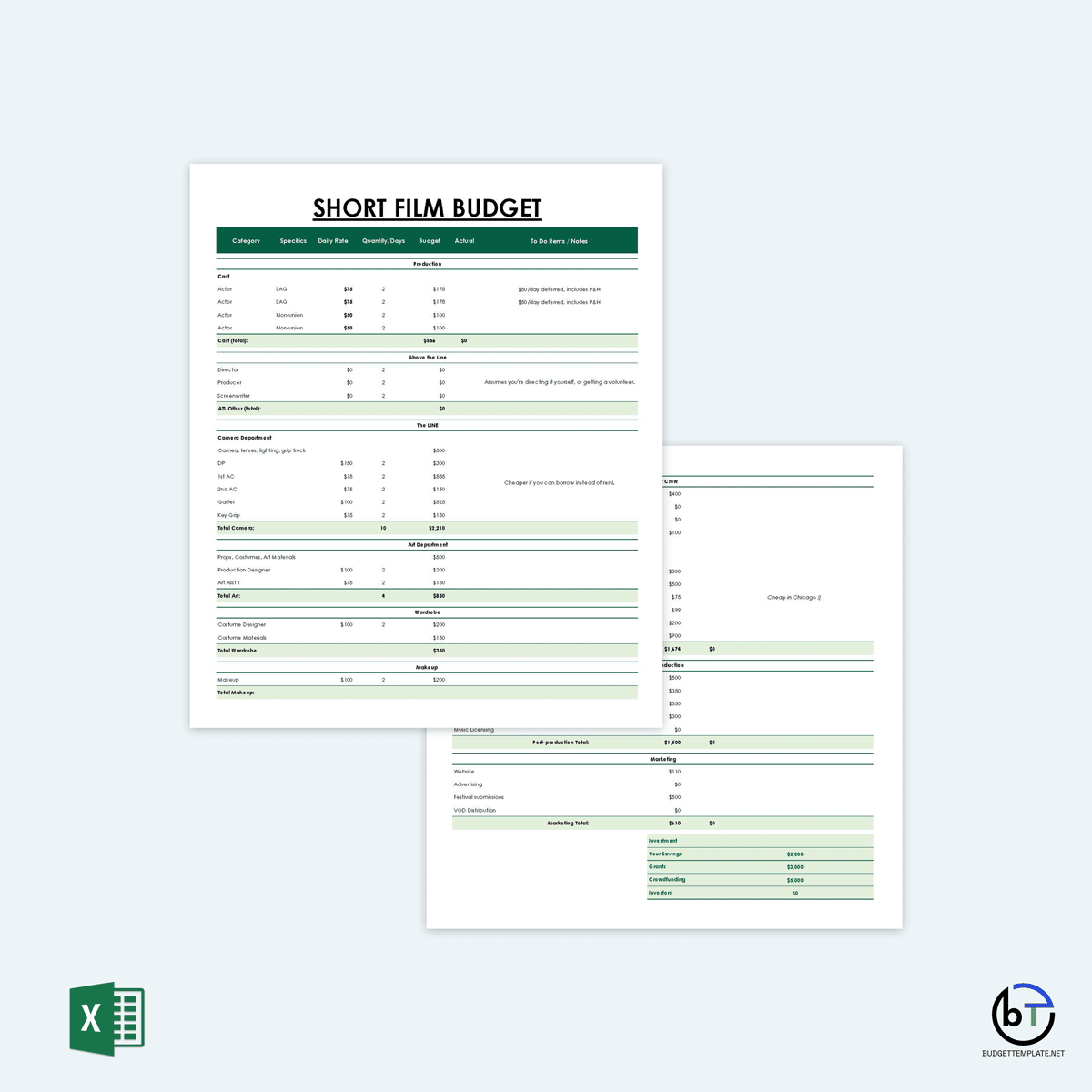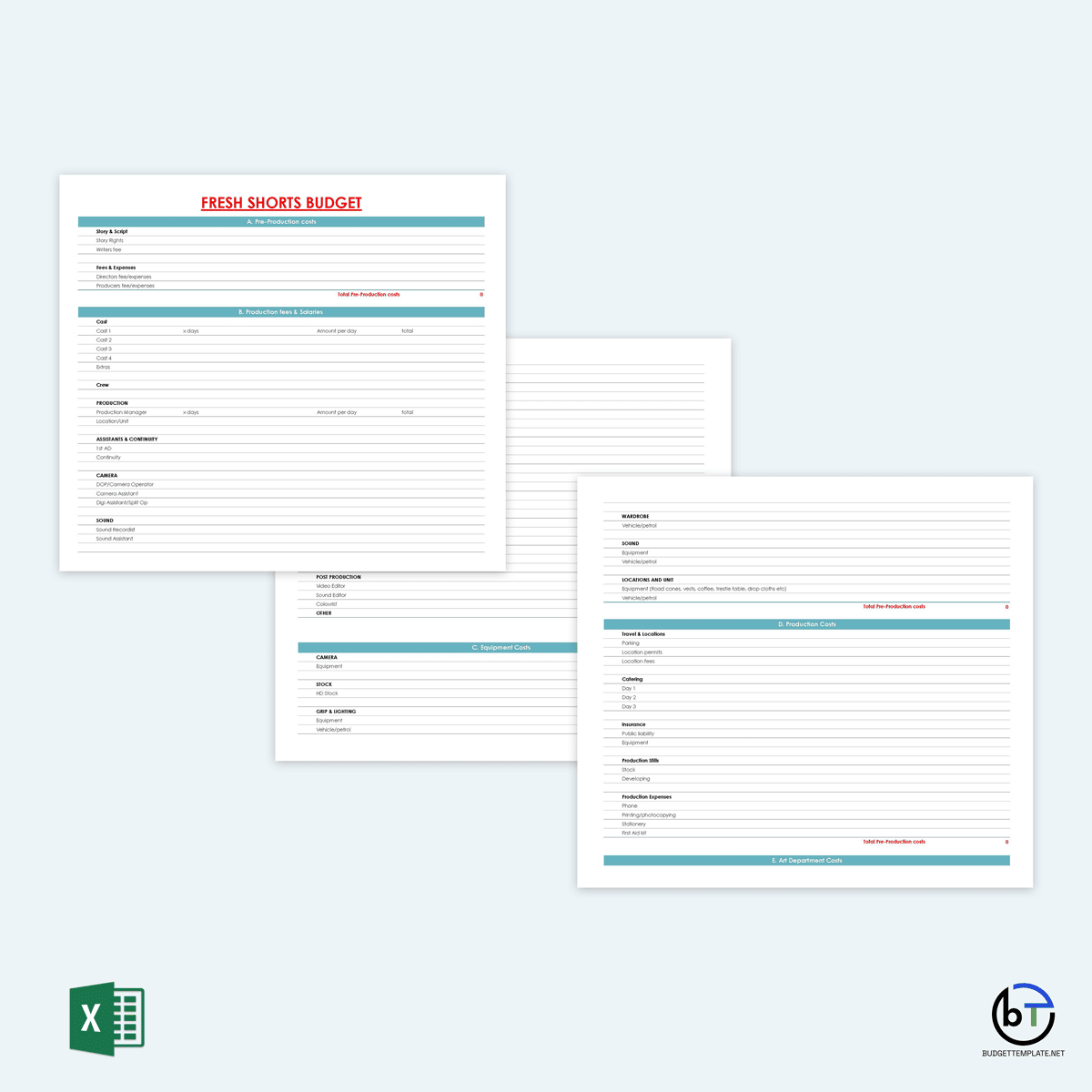There are many aspects of filmmaking that can make it a costly endeavor. These need to be considered when creating your short film budget template. The budget estimates how much money you plan to spend on a film. Keep in mind that the more intricate and elaborate your film, the more expensive it will be to make. For example, if you aspire to make a low-budget movie with a small crew, your budget will be accordingly small. However, if you want to make a feature film with a large crew and expensive equipment, your budget will also be huge.
This article makes this process easy by discussing what to include in a short film budget template and how to create one.
What to Include in a Short Film Budget Template?
Each film is different and has unique requirements. The best way to discover what you need is by assessing your script and discussing it with a few people before you start shooting.
Some of the fundamental items of a short film budget template include:
1. Length of the short film
The length of the short film is a significant factor in budgeting. Since short films are generally cheaper to make than feature films, their budget will vary accordingly, mainly depending on the pages of the script. Short films often have a runtime of 20 minutes or less. However, the Academy Standards state that short films range from 3 minutes to 40 minutes.
So, for example, a 12-minute film would cost about 2-3 times less to make than a 30-minute film with the same production quality and talent involved.
2. Production value
Production value is determined by the production design. It is expressed in terms of the genre, the complexity of scenes, and the production equipment you will be using.
Some of the costs associated with production are as follows:
2.1. Pre-production cost
Pre-production cost is the money you spend on planning and designing your short film. Before you start shooting, you need to make a short film budget template. It includes making a shot list, hiring directors of photography (DP) and other crew members, and other expenses like paying for casting calls, scouting shooting locations, hiring writers, and initial selection meetings. Pre-production costs typically should be between $250 and $500 (maximum).
2.2. Production cost
Production cost is the money you will spend on making the short film. It includes paying for equipment use and rental, location fees, props, costumes, etc. Production costs are the most significant percentage in a short film budget template, typically 75-80%. Therefore, completing this section of the budget is highly advisable. Below are the categories to expect in this section of a short film budget template:
- Location: The location, or setting, needs to be decided before you start shooting. Since you are shooting a short film, you might not have a budget for renting out an entire studio or location. You can also shoot outdoors if space and weather allow for it. Location costs will generally be between $250-$500 per day.
- Cast: The actors you cast in your short film will affect your short film budget significantly. The cast includes extras and those who have speaking parts but do not have significant roles (cameos). It does not matter if it is a speaking or an extra part, all of these need to be paid for. Hire cast from acting schools as they are more affordable, typically $100 per person per day, which can lower down to $50 a day.
- Crew: The crew of a short film includes the director, editors, art director, cinematographers, makeup artist, grippers, and other staff. The crew members are usually paid per hour or day for their services. In addition to this, they also need to be fed during the shoot. Crew members usually charge as follows:
- Cinematography – $150-$300 per day for less experienced cinematographers or $500-$1000 for experienced ones.
- The direction team – Charges between $100 and $150/day.
- Costume – Typically not more than $100 per day.
- Makeup artists – $100 – $150 a day.
- The sound recordist – Ranges from $150-$250.
- Types of equipment: This is a must-have section of this template. The types of equipment you will be using will depend on the nature of the short film. For instance, you may only need cameras and lighting if it is a drama. However, if your script requires several special effects, you will have to include additional equipment in this section. The critical thing to remember is that there are two categories of equipment: production and post-production. Equipment for production includes lights and cameras. Camera hiring costs range from $150-$500/day, lenses $50-$150/day, grips and jibs $50-$200, and Gaffer’s lighting equipment costs $150-$250.
- Art design: If your short film requires artwork, this is the right place to include it. The art design is another one of the factors that will influence your short film budget template. Art design includes props and costumes, makeup, and visual effects. Art design for a short film can cost $300 for art and $200 for the staff, but this depends mainly on the quality of work you want.
- Other production services: This section will include other expenses that do not fit in the other four sections. For example, catering, transportation, accommodation, and food are usually included in this section of your film.
2.3. Post-production cost
Post-production cost is the money you will spend after you have filmed your short film. It includes editing, color correction, and visual effects (VFX). The post-production costs are dependent on how elaborate the film is. For example, if you are going to use a lot of visual effects, then post-production costs will be higher. Categories under post-production are:
- Editing: Editing is a costly part of creating a short film. Editing costs range from $500- $1500, depending on the level of editing you need. This pricing is applicable for editors who use their editing suites.
- Sound design and music: Sound and music are other essential parts of creating a compelling short film. Sound mixing includes adding sound effects to your short film. It is essential to include this in your short film budget template. The cost of sound mixing ranges from $500-$1000, depending on the complexity of the mix you are planning to use.
- VFX expenses: This refers to computer-generated effects in a short film. To save costs under this category, you can hire students to add effects to your short film.
- Digital intermediate: Color grading is done mainly in the post-production stage of a short film. Color grading determines how viewers interpret your film. It has the power to change the mood of your film dramatically. It can correspondingly create a sense of realism or self-awareness in your story, and for this reason, you must hire experts for the best results. Costs can range from $100 per hour to $500.
It would be best if you aimed to pay at most $3000. This way, you don’t go overboard in spending during post-production.
3. Marketing and promotion
Marketing and promotion are critical in creating a short film, and they are a must-have in your short film budget template. This is the last major component of a short film budget template. You can use traditional and digital media platforms to promote your short film for marketing. However, if you use digital media, it will be more cost-effective. Film festival fees can also be included in this section.
How to Create It?
Creating a short film budget is not an easy feat to accomplish. However, you can make the process much less stressful by creating a template for it before you start filming. The following steps can be followed for this process:
Outline your production schedule
The first step you need to take is to outline your production schedule. The production schedule should include the shooting dates and times, days of shooting, and the budget for each day. It is advisable to shoot 3-5 pages of a script per day.
Start with hard costs
The first thing you need to include in your short film budget template is hard costs. The costs included in this section are those that cannot be changed once the short film production begins. For example, you can’t change equipment once it has been bought.
Specify actors and crew
Label each actor or crew member on your short film budget: name, role, experience, and salary. Each of the categories should be completed individually. You can also include a reference to any background they bring to their role with an explanation.
Plan your edit
Your short film budget should include a detailed breakdown of the time frame and resources for your edit. Calculate how much time it will take to edit your short film according to these shooting days and the length of the script. Also, include a description of the process you will use for editing your film in this section.
Include all costs
Finally, it is time to complete your short film budget template by filling in all the information that has been provided. You can complete it by adding them all up. Ensure that the total amount fits what you want for your short film. If it doesn’t, then make adjustments to your budget.
Tip: Cost of making short films
A short film will ordinarily cost between $700 and $1500. The costs are dependent on the length and production design. However, it would be best if you were aiming to make a short film within the budget you have or in the cheapest way possible.
Short Film Budget Templates
You can use many different templates to create your short film budget. This website has provided readers with free and customizable templates for short filmmaking. These templates will help you get started and independently make your short film budget. They will also guide you when creating your short film budget template.


Tips to Make a Low Budget
Creating a low-budget short film can be difficult. You may be tempted to cut corners and costs to get the film you want on the screen. However, when it comes to short films being too low-budget could mean that your short film flops at the box office. Here are some tips that will help you in this process:
- Stop making excuses: Your short film is an excellent opportunity to get your name and message. So stop making excuses or justifications for why you can’t create the film you want. You have the funds to make a quality short film! Being realistic about what you have available will help you create a high-quality short film that people enjoy watching.
- Write stories about those, you know: If you have friends and family who inspire you to write, create a story about them. Make sure that their personalities come across in your short film. These are the types of stories and characters that people can connect with, and it will also help you make your short film budget much lower.
- Don’t overspend: Creating a high-quality short film is possible with sufficient funds. Don’t spend so much money on equipment and locations. You don’t have enough film budget for that!
- Learn the proper filmmaking process: There are many different ways to make a short film. The right one isn’t necessarily the most expensive. But, learning the proper filmmaking process will help you make your short film more memorable and exciting while saving time and resources. Also, find creative ways to resolve challenges when filmmaking.
- Make the world small: Rather than a large-scale sci-fi or fantasy film, make a short film that happens in the real world. Make the characters more relatable to your audience and use local locations. Your audience will enjoy the movie, and you’ll be able to create a short film budget much lower. You can also use fewer actors, lesser scenes, fewer shots, etc. This will save you money in the long run.
- Don’t buy a camera: As a beginner, don’t go out and buy a camera. Rent one with all the features you need to make a great short film. Buying an expensive camera doesn’t necessarily mean that you will make a quality film. You can produce an excellent short film using a standard DSLR or cell phone camera.
Frequently Asked Questions
How to do marketing for a film?
You have a short film in the works. How can you market it to people? First, spend time researching the process of filmmaking and learn how to develop your short film. For example, do you have a script? Then, create a video to present your short film. Talk about what it is about, why it is essential, and who your audience is. Next, partner with other filmmakers in your city or online community, such as Youtubers, Instagrammers, and social media influencers, to promote your short film. Other marketing strategies include ads on local newspapers, posters, flyers, and local radio/TV stations. You can also ask family members, friends, and local businesspersons to share your ad.
How much does it cost?
Costing a short film requires balancing the numbers – costs, and revenue. Revenue will typically be dependent on how many people your film will reach. If you’re creating a short film for $500, you can use $500 for marketing totaling $1000 to make the film. You can make adjustments depending on your situation until the numbers make sense.









